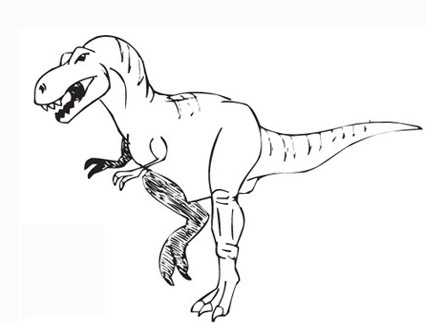Tyrannosaurus rex – What’s in a Name?
Tyrannosaurus rex – Did this animal really exist?
Tyrannosaurus rex is by far and away the most popular and famous dinosaur. When Everything Dinosaur team members visit schools, this is the dinosaur we get asked about the most. We have been fortunate to work with a number of tyrannosaur specimens and we have some excellent casts. It is great to see the way the children react when we present them with their very own plaster cast of a tyrannosaur tooth, one so well-preserved that the denticles (the individual saw-like serrations on the tooth) can still be seen and felt.
Tyrannosaurus rex
However, the taxonomy of the Tyrannosauroidea family is in need of some revision. Most palaeontologists agree that the current classification of these meat-eating theropods needs revising and the very name of Tyrannosaurus rex is indeed something of a misnomer.
Many people may be aware of the continuing debate amongst scientists about whether this large meat-eating dinosaur was primarily a scavenger or an active hunter. Tests carried out, estimating the bite force exerted at the tips of this large dinosaur’s teeth, indicate a bite force in excess of 3,000 lbs per square inch, easily enough to shatter bone. There are a number of examples of crunched up hadrosaur and ceratopsid bones in the fossil record uncovered to date that are testament to the powerful jaws of a tyrannosaur. However, whether, these fossils show feeding behaviour on a dead animal or indeed, the result of a Tyrannosaurus rex kill is very difficult to determine.
Tyrannosaurus rex – An Illustration

Picture credit: Everything Dinosaur
“King of the Tyrant Lizards”
The name Tyrannosaurus rex, such a well-known dinosaur, a name meaning “King of the Tyrant Lizards”, very nearly did not get used. In scientific circles, the naming of a new species has to follow strict criteria. If there is any confusion over the naming of a specimen, perhaps a newly named species, after further research is discovered to be actually another example of an already named and described species, then the earliest name used should take precedence.
Edward Drinker Cope, the famous American palaeontologist described some newly discovered dinosaur bones in 1892. The honeycombed internal structure of the fossilised bones (called camellate) is diagnostic of theropod and bird fossil vertebrae. Later Cope went onto name and describe a new dinosaur genus and species from these fossilised fragments. He called the new animal Monospondylus gigas (means “Giant Thin Vertebrae”). Scientists now know that these bones actually belonged to a tyrannosaur.
The Scientific Paper
When Henry Fairfield Osborn published his paper formally naming and describing T. rex in 1905 he actually published in the same report another formal description of what he believed at the time was another species of dinosaur. Osborn called this second dinosaur Dynamosaurus imperiosus (means “Imperial Power Lizard”). Some dermal armour had been found with this other fossil and Osborn assumed that the second, large meat-eating dinosaur described in this paper was covered in bony plates. It is likely some ankylosaur or nodosaurid remains had got mixed up with the tyrannosaur bones when these animals were buried and this is how the confusion arose.
Dynamosaurus
The animal referred to as Dynamosaurus was actually discovered first but in the paper it was the later, second find, known as Tyrannosaurus rex that got described first. Only later when Fairfield Osborn reviewed his work did he realise that these animals (in fact all three of Barnum Brown’s tyrannosaur finds between 1900 and 1906), represented what was to be termed Tyrannosaurus rex. The rules of scientific nomenclature state that the name that should take precedence in such cases is the first name published. By a few lines of text, Tyrannosaurus rex was established in favour of Dynamosaurus.
The first substantial fossil of the animal formerly known as Dynamosaurus but renamed T. rex representing a little over 10% of the actual skeleton and with skull material absent, was sold to the London Natural History museum. For a long, time these fossils were on display, the limited amount of actual fossil material supplemented by casts from other specimens and the creative use of a full size Tyrannosaurus rex illustration to help “flesh out” the exhibit. Some of our team members can remember seeing it on display, although much of the tyrannosaur material attributed to the Natural History museum is in storage.
The story of Dynamosaurus does not end there. The very few fossils of tyrannosaurs that scientists have do show morphological and anatomical differences. Could these be due to pathology, ontogeny or differences between the sexes? Maybe, or maybe not, could there really be several species represented by the tyrannosaur remains excavated from Hell Creek and other Upper Cretaceous formations? Some scientists have suggested for example, that the name Dynamosaurus imperiosus be revived and used to describe the more robust forms discovered with the more gracile specimens being referred to as Tyrannosaurus rex.
No doubt the debate will continue…
The uncertainty over tyrannosaurus is reflected in the many subtle variants seen in scale model dinosaurs. Schleich of Germany, for example, introduced a model showing a “moving” Tyrannosaurus rex and then more recently introduced another version of T. rex depicted in the “Kangaroo-like” pose with the tail dragging on the floor. The introduction of this second model coincided with the 100th anniversary of the naming and describing of Tyrannosaurus rex in the paper published by Henry Fairfield Osborn.
To view the moving T. rex and other dinosaur models: Dinosaur and Prehistoric Animal Models.

